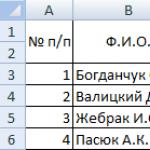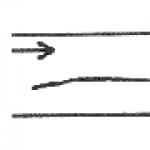What you need to know about the lens adapter. Types of adapters. Unusual Wi-Fi adapter for cameras. (Updated) Adapters for canon lenses
A lens adapter is needed in order to install a lens from a system other than its native system on the camera. For example, from the M42 system to Canon EF. Adapters are also called adapters (from the English word adapter).
A little theory
In addition to the fact that the adapter provides a mechanical connection between the lens and the camera, it also compensates for the rear section of the lens for its new system.
Posterior segment- this is the distance from the rear lens of the lens to the matrix at which focusing to infinity occurs. Each system has its own posterior segment.
There is also such a concept as working distance- the distance from the lens mount to the matrix, these terms are very similar in meaning, but I am still inclined to use the term “back segment” due to the fact that when adapting a lens to another system, it has a more relevant meaning.
Adapters can be classified according to several criteria, these are:
- autofocus, non-autofocus and chip adapters;
- adapters with and without lens;
- adapters with and without automatic aperture preset.
Let's look at each type in more detail.
Autofocus, non-autofocus and chip adapters
Autofocus adapters ensure the operation of autofocus lenses of one system on a camera of another, i.e. when using them, autofocus will work, of course, the lens must also be autofocus.

Such adapters are more difficult to manufacture and cost much more than non-autofocus ones. In addition to providing mechanical connection and compensation for the posterior segment, they must also provide electronic communication lens with a camera and in such a way that the camera considers it its own.
Yes, by the way, the Chinese recently came up with an idea for installing manual Leica lenses on the Sony E system; it is actually an autofocus helicoid. This was made possible by the fairly large back segment of some early Leitz lenses. Respect to the Chinese.

Adapter Nikon F - Canon EOS
Non-autofocus adapters are ordinary, mechanical adapters. Their design is usually simple - a metal ring, on one side attached to the camera mount, and on the other to the lens. Here there is only a mechanical connection and compensation of the working distance.

Chip adapter M42 - Canon EOS
Chip adapters are the same non-autofocus adapters, but on which a special chip is glued (Lushnikov chip or Chinese), which imitates an autofocus lens. The camera, unsuspectingly, reads information from the contacts of the chip and thinks that it is the lens of its native system. At the same time, both exposure metering and focus confirmation work. This adapter is much more convenient to use than a conventional adapter without a chip. Only aperture control and focusing remain manual.
Adapters with and without lens
Now let's figure out why there are adapters with a lens and why it is needed there. Up to this point, we have considered the case when the rear segment of the installed lens is larger than the rear segment of our system. For example, the rear segment of the Canon EF system is 44 mm, and the M42 system is 45.5 mm. To compensate for the rear (working) section of the Canon EF system, the working length of the adapter must be 1.5 mm.

Adapter M42 - Nikon with lens
Everything would seem simple, but what about the M42-Nikon F adapter? After all, the rear segment of the Nikon F system is 46.5 mm, 1 mm larger than the M42. This is where the difficulty lies. An adapter without a lens is only suitable if the rear section of the camera is larger than the lens. Or rather, it will work, but the lens will not be able to focus to infinity.
If we consider installing M42 lenses on Nikon through an adapter without a lens, then with telephoto lenses it will be possible to shoot a maximum of a full-length portrait, and the use of a fifty-kopeck lens or a wide-angle lens will be limited to macro shooting only.
In this case, a lens is installed. It compensates for the rear segments, but not mechanically, but optically. And then there will be infinity.
How does the lens in the adapter affect image quality?
Of course, it goes without saying that the lens has its influence on the image, and unfortunately it is a negative one. In other words, the lens in the adapter spoils the picture. This is due to the low optical quality of the lens. I will give a clear example of an image with and without a lens.

100% fragments of frames taken with a lens at f/ 2 with an adapter with a lens and with an adapter without a lens. Camera.
These are the pies. Even if the lens is of high quality, the lens design will still be different. Personally, I am not a fan of using lens adapters, but rather prefer converting lenses. But not all lenses can be remade; that’s another topic. .
Adapters with automatic aperture preset
These are adapters that, in addition to a blunt mechanical connection, also have a mechanism for pushing the diaphragm. I have only seen this with branded Tamron Adaptall shanks, but perhaps such adapters also exist in nature.

What determines the quality of the adapter
It would seem that the adapter is a simple piece of hardware, what could be wrong with it? But experience says otherwise. Let's consider the factors affecting the quality of the simplest mechanical adapter without a lens. So, we can distinguish two quality factors:
- exact working length;
- good blackening.
Exact working length
Sometimes I came across Chinese-made adapters that did not reach indefinitely, or, on the contrary, there was a slight gap. Well, it’s okay with the flight, you can get used to it, although it’s still inconvenient when it’s difficult to focus at infinity in low light conditions, and the camera doesn’t confirm focusing. But this is a special case.

Adapter screwed onto the Helios-44-2 lens
But when there is no infinity, the manufacturer cannot be forgiven for this. This is an open marriage. Sometimes it falls just a little short, some fractions of a millimeter. Of course, you can file it, or aperture the lens down to f/8, but this, as they say, is “not according to Feng Shui.”
There were also cases when the adapter had a slight misalignment of the axis. If the lens is not fast, then when normal shooting You may not notice it, but if it’s say 50mm f/ 1.4. then at a close distance I noticed that one corner of the frame was seriously overwhelmed in sharpness. Like this.
Good blackening of the adapter
How to identify an adapter with poor blackening
An adapter with a bad blackening shines on the inside, as if it were lubricated with oil. Unfortunately, it is not always visible in the photo if you buy an adapter online.

Two adapters Nikon F - Sony NEX from different manufacturers. On the left with good blackening, on the right with bad blackening
But if you clearly see a highlight of the interior in the photo, don’t take it. From experience. There are approximately 50/50 adapters on the market with good and bad blackening.
conclusions
In this article, I tried to briefly talk about lens adapters, based on my experience and observations, as well as reviews from familiar photographers. I hope this information was useful to you. If you have anything to add to this topic, write in the comments.
If you have a brand new Canon digital SLR camera, or you just want to get the maximum picture quality out of your Canon SLR and don’t have the money for very expensive professional lenses, manual optics comes to the rescue. In countries emerging from the former Soviet Union very popular Soviet manual optics.
Manual lenses are lenses with manual focus. Typically, manual lenses mean old lenses. In earlier times, lenses and cameras did not have automatic focusing. Please note that (all) is manual, i.e. cannot focus automatically. To work with a manual lens, you need to focus manually. This can be learned quickly.
Tessar 2.8/50 C.Z.Jena (GERMANY). Lens shown on digital SLR camera Canon EOS DIGITAL Rebel XSi adapter M42-Canon EOS with chip.
How to use old manual lenses on a Canon system? Very simple, to install the old one manual lens on a Canon camera you need to find out which mount (mount) the lens is designed for. Basically, there are not so many types of fastening, this is the good old M42 thread, H mount and M39 thread.
For lenses with M42 thread, an adapter is needed M42 - Canon EOS. This adapter is screwed onto the lens thread, and then the lens is installed on the camera. All Canon cameras will automatically meter exposure. Moreover, you can shoot in any camera mode, even automatic, although the aperture will need to be changed manually. It is very convenient to use the semi-automatic aperture priority mode (AV mode). When using an adapter M42 - Canon EOS will retain the ability to focus at infinity.

Regular adapter M42 - Canon EOS without chip
Attention 1. When using a regular M42 - Canon EOS adapter without a chip on the camera Focus confirmation will not work. This means that focusing will have to be done entirely by eye.
To solve this problem, you can buy an adapter with a chip. The chip usually allows focus confirmation and “fools” the camera, after which the camera thinks that it has its original lens on it. The chip is also called dandelion, less commonly Lushnikov dandelion. Dandelion can be programmed focal length lens and aperture value (you don’t have to do this). Therefore, the resulting images will contain all the lens parameters (possibly except for the focusing distance). You can buy the dandelion separately and attach it to the adapter, or you can buy the adapter with the dandelion right away.
Attention 2. The parameters specified in Dandelion (hardwired focal and aperture values) have virtually no effect on the operation of focus confirmation, but they do affect metering.
Where can I buy?
An adapter for lenses with an M42 mounting thread for installing them on Canon EOS digital cutting cameras can be purchased at this link.

Lens Super-Takumar 1:1.4/50 Asahi Opt. Co. Lens made in Japan. Lens shown on the Canon EOS DIGITAL Rebel XSi digital SLR camera. The lens was installed on the camera using .
Lenses with mounting threads include many, many lenses. For example, the Helios-44m-X family of lenses, some Jupiter lenses, some Industar lenses and others. A striking example is the Helios-44m-2 and Industar-50-2 lenses.

KALIMAR MC 50mm K-90 AUTO 1:1.7 COATED. Lens shown on the Canon EOS DIGITAL Rebel XSi digital SLR camera. The lens is installed on the camera using the PENTAX K - CANON EOS adapter.
For an H mount lens you will need to use an adapter. Yes, the H mount is the same as the Nikon system. Similarly, there is an adapter with and without dandelion. The most popular lenses with N mount: Helios-81N, MS Zenitar-N, MS Mir-47N, Mir-20N, MS Mir-24N, Telear-N, MS Granit-11N. Usually have the letter "H" at the end of the name. You can read more about this adapter.

Soviet lens MS Helios-44m-5 on Canon camera EOS Digital. The lens is installed on the camera using an M42-Canon EOS adapter without a chip.
For lenses with M39 thread, you need to use an adapter M39-EOS or two adapters M39-M42 and M42 - Canon EOS(picture below).
Pay attention, that lenses with M39 thread are available from two types of cameras - SLR and mirrorless. For normal operation Only lenses from SLR cameras with M39 thread, for example, such as Helios-44, . Lenses from rangefinder cameras can only be used in macro mode, in more detail.
Examples of lenses with M39 mounting thread
- (mirror version)
- (mirror version)
- (mirror version)
- (mirror version)
- (rangefinder version)
- (M39, white, rangefinder)
- (M39, white, rangefinder)
- rangefinder
- rangefinder
- rangefinder

Two adapters M39-M42 and M42 - Canon EOS without chip
Lenses from Kyiv-10, Kyiv-15 “AUTOMAT”
Lenses marked “Automatic” from the Kyiv-10 and Kyiv-15 cameras cannot be used on modern central control systems, since the lenses have a very short flange distance. I haven’t seen any adapters, and it will be difficult to resharpen.
Attention 3. When using lenses from rangefinder cameras under the M39 on the Canon system, the ability to focus at infinity will be lost, and in general, the focusing limit will be a few centimeters. This is due to different working lengths of native optics and mirrorless ones. Read more in the article.
For lenses with B mount, from medium format, you need a Pentacon Six (Kyiv-60) - Canon EOS adapter. The B mount is exactly the same as the Pentacon Six, which is available on the Kyiv-60 medium format cameras. If the Pentacon Six - Canon EOS adapter is difficult to find, then you can use two adapters - Pentacon Six-M42 and M42-Canon EOS. Lenses with B mount include , Jupiter-36B, .
For lenses with “B” mount,
from medium format, you need to use two adapters Kyiv 88/Salyut on Pentakon six + Pentacon Six (Kyiv-60) - Canon EOS. Pentacon SIX also called P6 and Pentacon 6 .
Attention 4. Mount “B” and “B” are two different mounts. People often confuse them. Be careful when choosing a lens.

Soviet Mir-1 lens on a Canon EOS camera
And there are also very interesting USSR lenses with interchangeable shank. Typically, lenses are designated with the letter "A" at the end of the name. This means that the back of the lens can be changed. You can install, for example, a shank with an M42 thread, or with an H fastening, whichever is needed is installed. Typically the shank is secured with three set screws, which are very easy to unscrew and then screw back. Such lenses include, for example, the legendary Jupiter-37A. To use it on a Canon camera, you should install two adapters KP-A\42 + M42 - Canon EOS on the lens. Well, or completely perverted KP-A\N + Nikon mount F - Canon EOS.

Soviet lens Industar-22 P
So, we installed the old lens on the camera - what to do next? When using Soviet optics on Canon cameras, you should always remember, What:
1. There will be no automatic focusing not on any Canon camera, even on the coolest Canon EOS 1DX. You will have to focus manually. Without a focus confirmation chip, it is very, very difficult to focus, especially with open apertures. I advise you to immediately get a dandelion (chip).
2. Some cameras have a mode Live View- it will help you get into focus. Even with a dandelion mounted on the lens, the success rate of focusing with Live View is much higher. It is very convenient to scale images in Live View for even more precise focusing.
3. Some lenses require modification of the aperture control method. This usually comes down to the fact that you need to block the blinking diaphragm mechanism so that the diaphragm can be controlled manually.
Hello dear Muskovites!
Today I present a review of a very unusual thing, the existence of which I did not even suspect))
So!
I present to you a Micro SD adapter with Wi-Fi!
Briefly about the review - Definitely worth taking!!!
All the details are under the cut)
I noticed this lot quite by accident while scouring the vastness of aliexpress.
After reading the instructions for it and understanding why it was needed, I decided to order)
I was so excited about the idea of owning such a thing that I didn’t even look at the seller’s rating. After payment, I remembered this and was very scared) After all, his rating was almost zero. But as it turned out, I had no need to worry!!!
Let's start with what this product is intended for.
This product combines both a memory card and a small Wi-Fi transmitter. After inserting a small MicroSD memory card into this adapter and installing it in the camera, when the latter is turned on, a Wi-Fi network is created. Next, we connect to it (network with password 88888888) and on any mobile device we either go to the manufacturer’s website or after downloading special program, we see all the photos taken from the camera on the screen of your mobile device.
The parcel arrived just with lightning speed) Only 11 days. On this moment, this is a record for me. The parcel itself is a yellow bag with a bubble wrap inside. 
For those who like tracking numbers

Along with the goods, the parcel included a small postcard from the seller) A trifle, but nice.

The product packaging was perfect. Nothing was wrinkled anywhere. The packaging is made in the style of a book. The top is quite thick cardboard and the inside is plastic.



There are 3 QR codes on the back. 1 to the support site and 2 to applications on GooglePlay and AppStore. I checked only one - the AppStore, since I don’t have Android devices at home) The code works, although the application is only available to users of the Chinese AppStore. But it doesn’t matter) I found a very convenient application in the Russian AppStore, but more on it later)
The package is simple:
1. The adapter itself
2. Packaging
3. Instructions in Chinese and English 
In principle, the instructions are simple. The only point is that when you first connect to Wi-Fi networks my device required a network password. And only after that I started studying the instructions (for those who are especially lazy and don’t read instructions - Password: 88888888). 
Photo instructions close-up

As I already said, I found the application in the Russian AppStore. It's called ez Share HD 
Quite an interesting and beautiful application. No glitches were noticed. 
I will not describe all the features of this application. I'll focus on the most important thing - viewing photos.
And to do this, just click on Card Album, after which you can see all your photos. 
To view a photo in detail, you just need to click on it, after which it will load. The loading indicator is large. 


Conclusion:
This product can be classified as a Must Have for people who often take photographs and do not like to waste time transferring photos to a computer. Personally, I really liked this adapter and I don’t regret spending money on it at all!
I recommend it to everyone!
Updated
At the request of some people, I am attaching photos of memory card reading tests with and without an adapter: 
On the left is a test of a “bare” memory card, on the right is a test of a memory card together with an adapter.
For tests I used a 16 GB Mirex memory card. 
How often have you forgotten the connecting cord for your camera and couldn't quickly share your photos with friends? What about modern tablets? They all support only MicroSD. Therefore, the cord to the camera or the adapter from MicroSD to your device is something that you always have to remember... I had to remember before you started reading this article :)
What if I told you that today almost any camera can be turned into a camera with Wi-Fi access. And your electronic friend, upgraded in this way, can be quickly connected without a cable to any device: smartphone, tablet or laptop. Don't believe me?
The progress of Wi-Fi implementation has reached such limits that it is already being built into everything - and this is not only smartphones, pens and refrigerators, but even coffee makers and toothbrushes. But for me, the most amazing thing was the introduction of Wi-Fi into an ordinary SD memory card! You can't even imagine how many problems there are to use digital camera(and more!) is solved by this device.
Introducing the ezShare Wireless WiFi SD card adapter - which combines both a memory card and a small Wi-Fi device. After inserting a MicroSD card into the adapter and installing it in the camera, when the latter is turned on, a Wi-Fi network is created. Next, we go to the manufacturer’s website and, after downloading a special program, connect to the Wi-Fi adapter (network with password 88888888). Now we can not only see all the photos taken from the camera on the screen of your mobile device, but also quickly download and share the photos with friends. What kind of adapter laces? Forget it!
The adapter packaging is made in the form of a book. There are three QR codes on the back. One for the support site and two for applications in GooglePlay and AppStore. I checked only one - AppStore). The application is working, although it is only available to users of the Chinese AppStore. But this is not a problem - I quickly found a very convenient application in the Russian AppStore and it’s called ez Share HD.

Equipment:
- Wi-Fi SD adapter
- Package
- Instructions in Chinese and English

The instructions are simple. When I first connected to the Wi-Fi network, my device required a network password - password: 88888888 (eight eights - found in the instructions).



Where can you buy this miracle? This is the adapter I purchased as part of the package adapter + microSD 16 GB .
If you just need an adapter, I recommend looking at this page and choosing the option WiFiadapter. They also sell WiFi SD with built-in memory of 8, 16 and 32 GB. But this is no longer an adapter, but a full-fledged SD memory card and Wi-Fi. Personally, this was not suitable for me, since I have about a dozen MicroSD. It is worth noting that Toshiba has a similar solution and is called Flash Air.
Maybe someone will like this option adapter + card reader - .
An updated version of this device has appeared, which is capable of reading and transmitting not only images, but also videos, documents and other types of files. Thus, now you can turn a simple digital video camera with recording on an SD card into a video camera with Wi-Fi with a couple of tens of dollars.
Fabulous!






